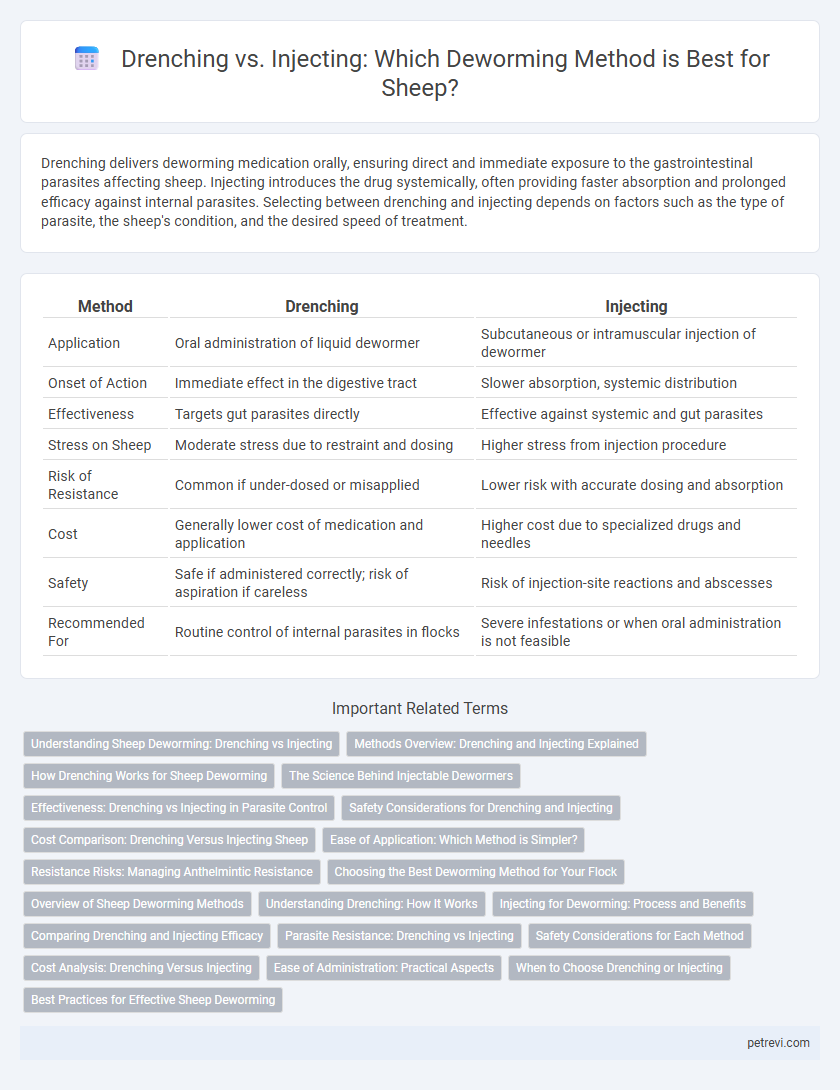Drenching delivers deworming medication orally, ensuring direct and immediate exposure to the gastrointestinal parasites affecting sheep. Injecting introduces the drug systemically, often providing faster absorption and prolonged efficacy against internal parasites. Selecting between drenching and injecting depends on factors such as the type of parasite, the sheep's condition, and the desired speed of treatment.
Table of Comparison
| Method | Drenching | Injecting |
|---|---|---|
| Application | Oral administration of liquid dewormer | Subcutaneous or intramuscular injection of dewormer |
| Onset of Action | Immediate effect in the digestive tract | Slower absorption, systemic distribution |
| Effectiveness | Targets gut parasites directly | Effective against systemic and gut parasites |
| Stress on Sheep | Moderate stress due to restraint and dosing | Higher stress from injection procedure |
| Risk of Resistance | Common if under-dosed or misapplied | Lower risk with accurate dosing and absorption |
| Cost | Generally lower cost of medication and application | Higher cost due to specialized drugs and needles |
| Safety | Safe if administered correctly; risk of aspiration if careless | Risk of injection-site reactions and abscesses |
| Recommended For | Routine control of internal parasites in flocks | Severe infestations or when oral administration is not feasible |
Understanding Sheep Deworming: Drenching vs Injecting
Drenching involves orally administering liquid dewormers to sheep, targeting gastrointestinal parasites directly, while injecting delivers dewormer substances intramuscularly or subcutaneously for systemic absorption. Both methods require accurate dosing based on the sheep's weight to ensure efficacy and prevent resistance development. Proper deworming protocols prioritize parasite control, animal welfare, and maintaining optimal flock health.
Methods Overview: Drenching and Injecting Explained
Drenching involves orally administering a liquid dewormer directly into the sheep's mouth, ensuring precise dosage to target gastrointestinal parasites effectively. Injecting delivers anthelmintics via subcutaneous or intramuscular routes, providing rapid absorption and longer-lasting parasite control. Both methods require correct dosing based on weight and parasite resistance patterns to maximize efficacy and minimize resistance development.
How Drenching Works for Sheep Deworming
Drenching for sheep deworming involves orally administering a liquid anthelmintic directly into the animal's mouth, ensuring the medication reaches the stomach and intestines where worms reside. This method allows for targeted dosing based on body weight, improving efficacy against gastrointestinal parasites like Haemonchus contortus and Trichostrongylus species. Proper drenching technique and equipment maintenance are critical to maximize absorption and prevent underdosing or resistance development.
The Science Behind Injectable Dewormers
Injectable dewormers deliver active ingredients directly into the bloodstream, ensuring rapid absorption and systemic distribution that targets gastrointestinal parasites more effectively than oral drenches. The bioavailability of injectable formulations circumvents issues like reduced efficacy due to digestive degradation or incomplete consumption common in drenching methods. Pharmacokinetic studies reveal that injectables maintain therapeutic drug concentrations longer, enhancing parasite control and reducing the risk of resistance development in sheep populations.
Effectiveness: Drenching vs Injecting in Parasite Control
Drenching delivers anthelmintic medication orally, providing direct contact with gastrointestinal parasites, which often results in effective immediate parasite reduction. Injecting administers the dewormer systemically, allowing for broader absorption and efficacy against parasites resistant to oral treatments. Comparative studies indicate injecting may offer enhanced parasite control in multi-drug resistant nematode populations, while drenching remains effective for targeted gastrointestinal parasite management.
Safety Considerations for Drenching and Injecting
Drenching sheep for deworming requires careful administration to avoid aspiration pneumonia caused by incorrect throat placement, as well as ensuring the accurate dosage to prevent toxicity or underdosing. Injecting dewormers demands strict adherence to aseptic techniques and appropriate site selection to reduce risks of injection site abscesses and systemic reactions. Both methods necessitate consideration of animal welfare, with drenching posing risks of stress and injury, while injections carry potential complications linked to technique and product formulation.
Cost Comparison: Drenching Versus Injecting Sheep
Drenching sheep for deworming generally incurs lower upfront costs due to inexpensive oral wormers and minimal equipment, making it a budget-friendly option for large flocks. Injecting requires higher initial expenses for veterinary services and sterile syringes, but it offers precise dosing and longer-lasting efficacy that may reduce overall treatment frequency. Evaluating per-animal cost efficiency depends on flock size, labor availability, and parasite resistance patterns, with drenching favored for routine mass treatments and injecting preferred for targeted, high-value animals.
Ease of Application: Which Method is Simpler?
Drenching sheep involves administering liquid medication orally, requiring careful restraint and precise dosing, which can be time-consuming and demands skill to ensure the full dose is swallowed. Injecting offers a faster alternative, with subcutaneous or intramuscular routes providing direct delivery of anthelmintics, minimizing the risk of dosing errors and reducing the handling time per animal. For large flocks, injection is often simpler and more efficient, while drenching may be preferred for targeted treatment or when injection equipment is unavailable.
Resistance Risks: Managing Anthelmintic Resistance
Drenching sheep with oral anthelmintics delivers direct exposure to gastrointestinal parasites, increasing the risk of developing resistance due to sub-lethal dosing or frequent treatments. Injecting dewormers allows for controlled dosage and prolonged release, potentially reducing resistance selection but may not target all parasite stages effectively. Integrated parasite management, including rotational use of anthelmintic classes and targeted selective treatments, is essential to managing anthelmintic resistance in sheep flocks.
Choosing the Best Deworming Method for Your Flock
Selecting the best deworming method for your flock depends on factors such as parasite load, sheep age, and ease of administration. Drenching allows for immediate gastrointestinal parasite control and dosing accuracy, while injecting delivers systemic efficacy and longer-lasting protection. Regular fecal egg counts and consultation with a veterinarian guide effective parasite management and reduce resistance risks.
Drenching vs Injecting for Sheep Deworming Infographic

 petrevi.com
petrevi.com